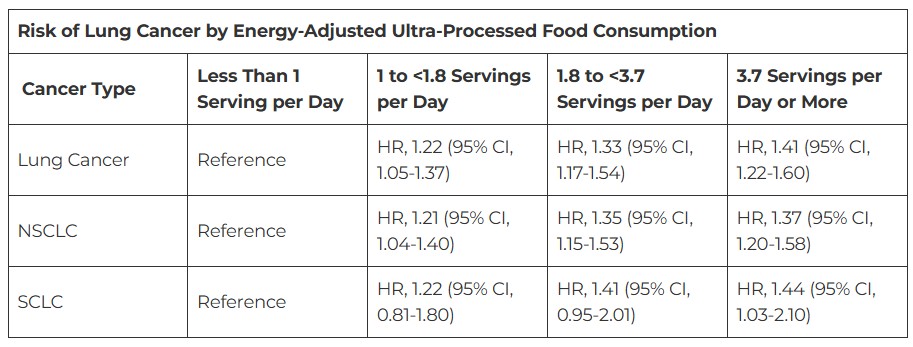
High Consumption of Ultra-Processed Foods Linked to Elevated Lung Cancer Risk
People who consume the highest amounts of ultra-processed foods may face a significantly higher risk of developing lung cancer, according to a study published in Thorax.
Researchers reported that individuals in the highest quartile of ultra-processed food intake had:
- 41% greater overall risk of developing lung cancer compared with those in the lowest quartile.
- 37% higher risk of developing non-small cell lung cancer (NSCLC).
- 44% higher risk of developing small cell lung cancer (SCLC).
Study Overview
The findings come from an analysis of data from the Prostate, Lung, Colorectal, and Ovarian (PLCO) Cancer Screening Trial (NCT00002540, NCT01696968, NCT01696981, NCT01696994) — a large, randomized trial assessing cancer screening methods.
The analysis included 101,732 participants (51,545 women and 50,187 men), with an average age of 62.5 years at baseline. On average, participants consumed 2.8 servings of ultra-processed foods per day.
Over an average follow-up period of 12.2 years, there were 1,706 cases of lung cancer, including:
- 1,473 NSCLC cases (86.3%)
- 233 SCLC cases (13.7%)

What Counts as Ultra-Processed Foods?
For this study, ultra-processed foods were defined as heavily industrially manufactured items such as:
- Sour cream, ice cream, fried foods, bread, cookies, cakes, salty snacks
- Breakfast cereals, instant noodles and soups, sauces, margarine, candy
- Soft drinks, artificially sweetened fruit drinks
- Fast-food items like hamburgers, hot dogs, and pizza
Key Findings
When researchers divided participants into quartiles based on their energy-adjusted ultra-processed food intake, they observed a clear trend — the higher the intake, the greater the risk.
Those in the top quartile had a hazard ratio (HR) of 1.41 (95% CI: 1.22–1.60) for lung cancer compared to those in the lowest quartile. This means a progressive increase in risk with each step up in ultra-processed food consumption.
“In this population-based study, high consumption of UPF is associated with increased risks of lung cancer, NSCLC, and SCLC, independent of multiple potential confounders,” the researchers wrote. “These findings need to be confirmed by other large-scale longitudinal studies in different populations and settings. [F]uture studies should elucidate potential molecular mechanisms and increase understanding of the observed associations.”
Disclosures: This research was supported by Chongqing University Cancer Hospital and grants from the Chongqing Talent Plan and Chongqing Shapingba District Technological Innovation Project. The study authors reported having no conflicts of interest. Please see the original reference for complete disclosures.
